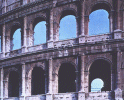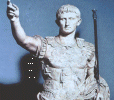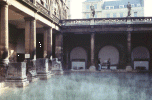Ancient Rome |
Ancient Rome |
 | Bearded Roman river god watches Roman soldiers build a pontoon bridge across the Danube, a famous event in the Dacian campaigns. Detail from Trajan's Column, 106-113 CE. |
The Romans often followed Greeks models in the design of their temples and theaters, in paintings and mosaics, and in freestanding sculpture. Still, their art and architecture is unique in a number of ways. They were masterful engineers -- putting to use the so-called "Roman arch" in bridges and aqueducts, inventing concrete for the construction of huge structures, and building roads to connect the vast stretches of their empire. They were superb organizers and urban planners, designing whole cites from scratch. They laid out these cities according to a logical grid and furnished the amenities Romans thought necessary for a civilized life: abundant water, baths, libraries, civic buildings and temples, sports arenas, and the now infamous amphitheaters.
Two kinds of architectural structures are especially important. Although the Romans built temples and civic buildings, some of their largest and most unique buildings were designed for leisure time activities. These were their public baths and amphitheaters. In addition, they invented structures for the aggrandizement of the empire -- the triumphal arch and the triumphal column. Neither served any practical purpose but were as propaganda. Later cultures have copied Roman amphitheaters, triumphal arches, and triumphal columns.
 |
Roman Architecture |
 |
Portrait Sculpture |
 |
Public Baths |
 |
Villa of Mysteries, Pompeii |
All images marked MAS were photographed on location by Mary Ann Sullivan. All other images were scanned from other sources or downloaded from the World Wide Web; they are posted on this password-protected site for educational purposes, at Bluffton College only, under the "fair use" clause of U.S. copyright law.